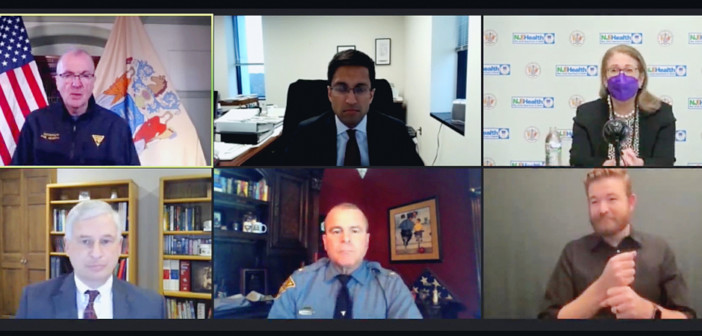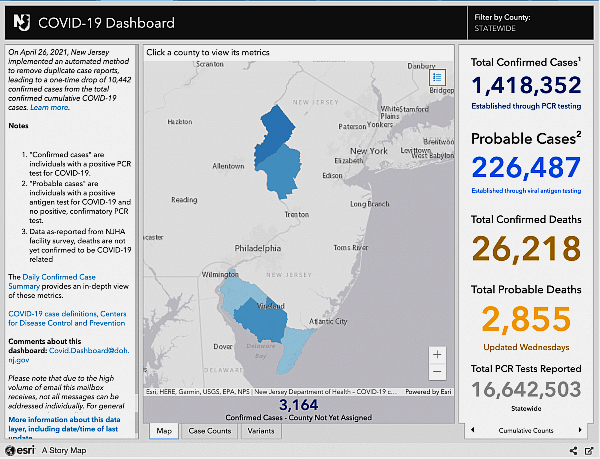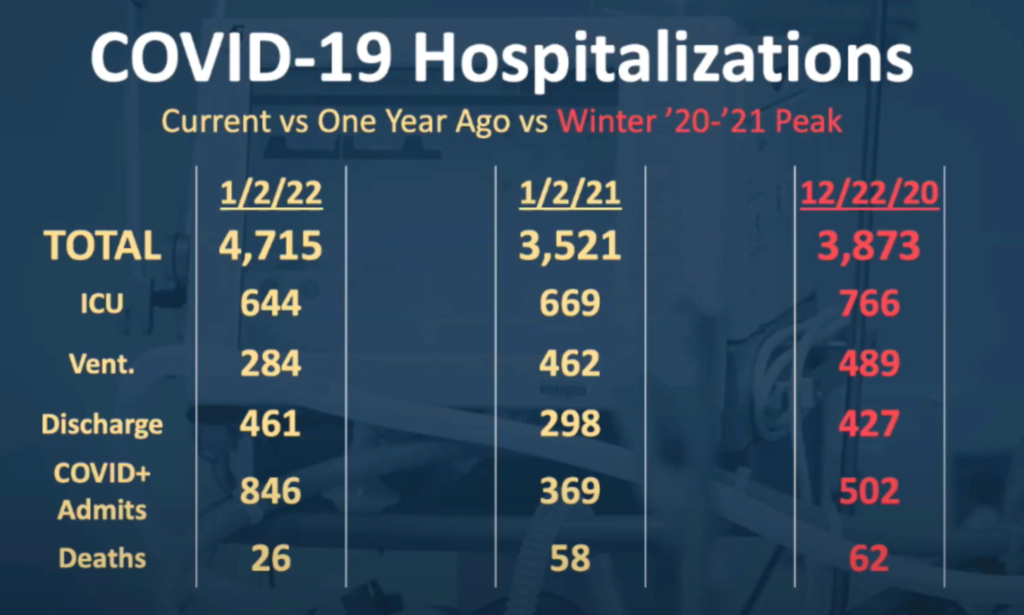Given the volume of at-home tests conducted across the state, Governor Phil Murphy regards the staggering infection totals ‘as a floor,’ as hospitalizations hit levels unseen since May 2020.
By Matt Skoufalos | January 3, 2022
Another 20,428 New Jersey residents have tested positive for novel coronavirus (COVID-19), bringing the statewide total to 1.418 million cases confirmed via polymerase chain reaction (PCR) testing, Governor Phil Murphy reported Monday in the first state briefing of 2022.
New Jersey is also reporting 2,197 new COVID-probable cases based on antigen tests, bringing the statewide total to 226,487 positive antigen tests.
Antigen tests have a faster turnaround time than PCR tests—sometime within 15 to 30 minutes—but are less reliable at detecting active infection of the virus, and more capable of reporting false positives.
Both counts are record, single-day totals amid what Murphy termed an “omicron [variant] tsunami [that] has changed the game yet again.”
Given that the results of an unknown volume of home tests aren’t being reported to health authorities, Murphy advised residents to regard those totals, staggeringly high as they are, “as a floor.”
“The numbers we’re seeing today blow any we’ve seen at any part of the pandemic out of the water,” he said.
Despite the existence of some 1,000 COVID-19 testing sites across the state, the governor acknowledged that lines are long and few appointments are available. Even the free test kits mailed by Vault Medical Services have been capped at 30,000 tests daily, a wall some residents hit when trying to order a test over the holiday weekend.
“We’re seeing new case counts that dwarf what we’re seeing even in the earliest days,” Murphy said. “The fight is not over, but we can shorten it if we all take this seriously.”
The governor used his own family’s circumstances as an example: First Lady of New Jersey Tammy Murphy, who is both fully vaccinated and boosted, tested positive twice over the weekend (the governor did not).
“This thing is crazy transmissible,” Murphy said.
Sadly, 12 more residents have perished from complications related to the virus, bringing the statewide, confirmed death toll to 26,218 lives lost during the pandemic.
In addition to those lab-confirmed fatalities, the state has acknowledged another 2,855 probable COVID-19-related deaths—13 more than previously reported.
Since March 2020, 1,151 of every 100,000 New Jersey residents (more than one out of every 100) have been hospitalized with COVID-19, and 298 of every 100,000 have died from COVID-19-related complications.
More than 16.642 million polymerase chain reaction (PCR) tests for COVID-19 have been performed statewide, with a 15.90-percent positivity rate per 100,000 residents.
Rate of transmission (Rt) at 1.77, spot positivity lowest in South Jersey
The statewide average of COVID-19 spot positivity testing based on PCR test results stood at 32.2 percent December 30; in South Jersey, it was lowest, at 28.22 percent.
Rt, the variable that describes the seven-day, rolling-average, statewide rate of transmission of new COVID-19 cases, rose to 1.74 on January 3.
An Rt figure of 1.0 means that each new COVID-19 patient is infecting more than one other person, on average, and the spread of the virus is increasing.
Since its mid-April-2020 pandemic-high spike, the highest reported RT in New Jersey was 1.48, recorded August 1, 2020. Prior to artificially low, adjusted reports of 0.34 in the first week of May, the lowest in the past year was 0.62, recorded June 9, 2020. On May 21, 2021, it reached a new low, of 0.59.
COVID hospitalizations climb to levels unseen since May 2020
Throughout New Jersey, 4,715 people currently are hospitalized with a suspected (106) or confirmed (4,609) case of COVID-19, Murphy said.
That’s half the total during the pandemic peak of 8,270 during April 2020, he said, and a direct result of “the sheer numbers of new cases,” he said.
“We have more people in the hospital today than at any point in the past year, and the most since the early part of May 2020,” Murphy said.
The governor also reported that roughly 70 percent of those patients “are unvaccinated or not completely vaccinated.”
Among those hospitalized patients, 644 are in intensive or critical care, and 284 of the ICU and critical-care patients (50 percent) are on ventilators.
That’s still shy of the April 2020 ICU peak of 2,080 patients.
In New Jersey’s 71 critical care hospitals, 846 patients were hospitalized with COVID-19 yesterday, while 461 others were discharged.
Due to the spike in volume, many hospitals have no choice but to pare back services; New Jersey Health Commissioner Judy Persichilli reported that selective and optional procedures (Levels 4 and 5) are being temporarily suspended.
Persichilli also reminded residents that “the emergency rooms are not COVID testing sites,” and urged them to “use state resources to find one of the 1,000 testing sites across the state.
Meanwhile, the pandemic is also driving staffing shortages at hospitals across the state, and subsequently, health officials have made requests of the U.S. Federal Emergency Management Agency (FEMA) for “federal strike teams” to support hospitals and long-term care (LTC) facilities.
The state will not pursue offsite clinics, which had been erected as overflow facilities during the early months of the pandemic, because they were more of a strain on existing hospital resources, Persichilli said.
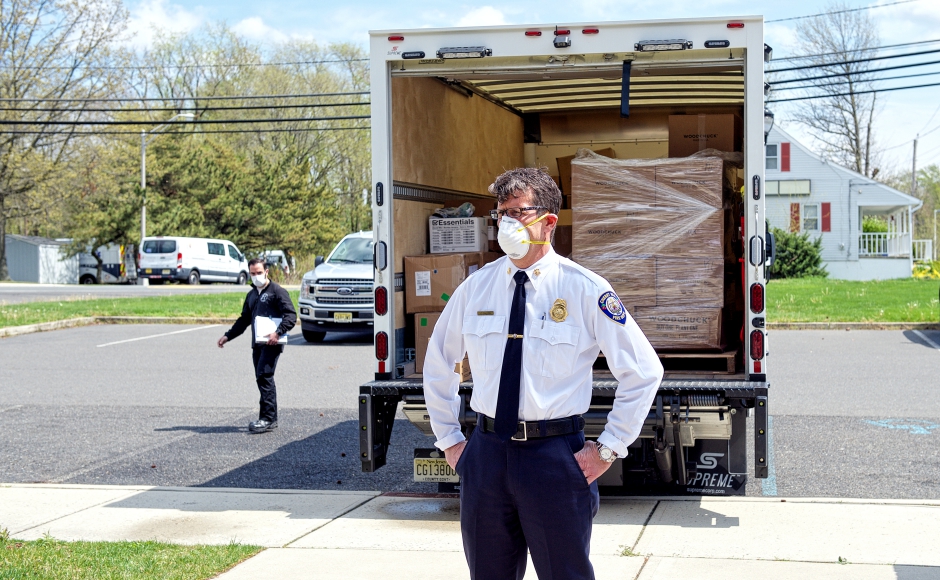
File Photo: Cherry Hill Fire Chief Chris Callan oversees a delivery of PPE for Camden County LTCs. Credit: Rich Ratner.
LTC update: outbreaks, infections, deaths climb
Across the state, long-term care (LTC) centers have reported 1,980 cumulative outbreaks of COVID-19, and 439 are dealing with an active outbreak.
LTCs account for 59,858 infected patients and staff in New Jersey, or 4.9 percent of total cases.
That includes 36,998 residents and 28,860 staffers sickened by the virus, as well as 8,775 lab-confirmed resident and staff deaths (34 percent of the statewide confirmed total), with facilities self-reporting 145 staff deaths.
Of 635 veterans residing in three state-run homes, 456 residents have tested positive for COVID-19, and 161 have died from complications related to the virus—three more than previously reported. Three hundred veterans have recovered from the virus, and 32 currently are COVID-19-positive.
The facilities at Menlo Park, Paramus, and Vineland are staffed by 1,371 workers, 10 of whom are presently COVID-19-positive. The facilities have sustained two staff deaths related to the virus.
At state-run psychiatric hospitals, 378 of 1,139 patients and 1,136 staff members have tested positive for COVID-19. Fourteen patients and eight staffers have died from complications related to the virus, and 75 are currently positive.
MISC and school cases up
To date, 155 New Jersey children aged 1 to 18 have been diagnosed with pediatric multisystem inflammatory syndrome (MISC)—three more than previously reported. Five of those cases were reported in Camden County, which tied with Cumberland and Monmouth Counties for sixth-fewest in the state.
All those pediatric patients have tested positive for an active COVID-19 infection or the presence of COVID-19 antibodies, indicating exposure to the virus. No deaths have been associated with this syndrome in New Jersey, although several children have been hospitalized during their treatment for the illness.
From August 1, 2020 through the end of the 2020-2021 school year, 293 COVID-19 outbreaks encompassing 1,385 individual cases were traced to in-school activities in all 21 New Jersey counties. In Camden County, 18 outbreaks were linked to 78 in-school cases, sixth-most in the state.
Since the start of the 2021-2022 school year, 373 reported outbreaks—three or more students or staff who contracted the virus within the school—have been logged, affecting 2,123 people, a mix of students and staff.
In Camden County, 39 COVID-19 outbreaks have accounted for the in-school infections of 295 people, which is the largest case count of any county in the state, and more than the county had sustained in the entire prior school year.
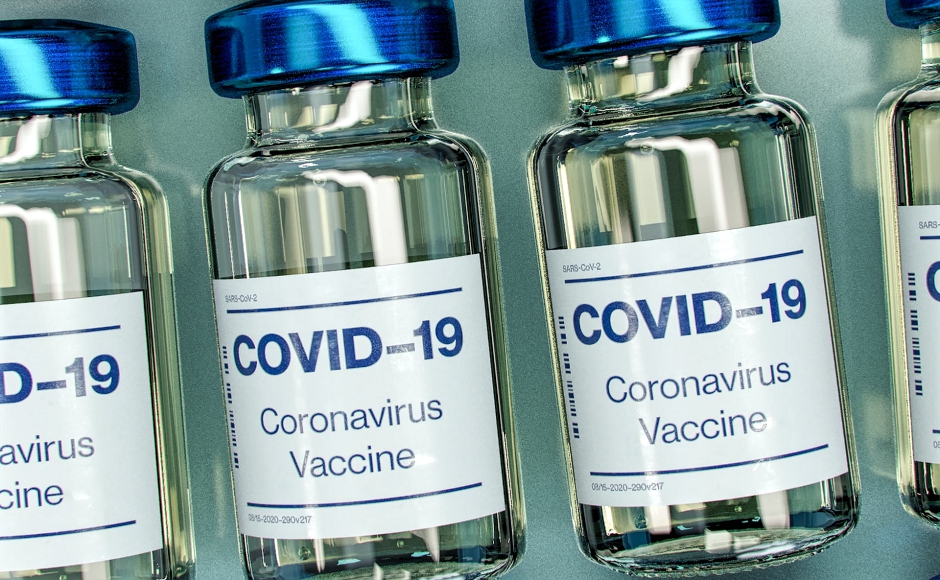
COVID-19 vaccine bottle mock-up. Photo by Daniel Schludi on Unsplash
Vaccination update: NJ clears 13M doses, booster uptake still insufficient
More than 13.031 million primary-series COVID-19 doses have been administered in New Jersey, with 6.219 million people have been fully vaccinated in-state, having received either a one-shot formulation from Johnson and Johnson or both doses of the two-shot Pfizer or Moderna vaccines.
In Camden County, 691,539 doses have been administered, seventh-most in the state; 334,485 people have been fully vaccinated.
An estimated 512,890 vaccine doses have been administered to New Jersey residents outside of the state, of which 210,394 residents are estimated to have been fully vaccinated.
Vaccination sites in New Jersey have also administered 79,175 Pfizer third/booster doses, 49,121 additional Moderna doses, and 2,892 additional Johnson and Johnson doses.
The unvaccinated remain at the greatest risk of serious illness or death from omicron, Persichilli said, urging all residents to receive their shots and boosters; only 35 percent of those eligible have received one.
The health commissioner also pointed out that those who received a Pfizer primary series is eligible for a booster at five months instead of six, which includes some 155,000 (61 percent) 12-to-15-year-olds; similar approvals are expected for the Moderna boosters as well.
Kids 5-11 who’ve received a solid organ transplant, or who are considered moderately or severely immunocompromised, are eligible for an additional Pfizer dose 28 days after completing the initial series.
The first vaccines in the state were administered December 15, 2020; by February 8—55 days later—New Jersey had immunized its millionth resident. Twenty days thereafter, that count hit 2 million, and 3 million within two more weeks.
On March 29, New Jersey crossed the 4-million-dose threshold, and the state cleared 5 million doses over the weekend of April 10, 2021. Eight days after that, New Jersey hit the 6-million-dose mark. By May 3, 2021, the state had cleared 7 million doses administered, and two weeks later, it had surpassed 8 million doses.
As of June 2, 2021, the state had cleared 9 million administered doses and 4 million fully vaccinated New Jerseyans, and on June 18, hit 4.7 million vaccinated individuals, its target goal for 70 percent of the adult population of the state.
By mid-July, that number had increased to 5.019 people fully vaccinated at New Jersey vaccination sites. At the end of August 2021, the state had exceeded 11 million doses administered and had begun approaching 6 million fully vaccinated residents.
It took until mid-October 2021 to clear the 12-millionth vaccine dose administered, at a time when some residents have begun receiving booster doses or third doses. By late October, New Jersey finally reached an estimated 6 million fully immunized residents, nearly three months after having crossed the 5-million-resident threshold.
Please support NJ Pen with a subscription. Get e-mails, follow us on Facebook, Twitter, and Instagram, or try our Direct Dispatch text alerts.

